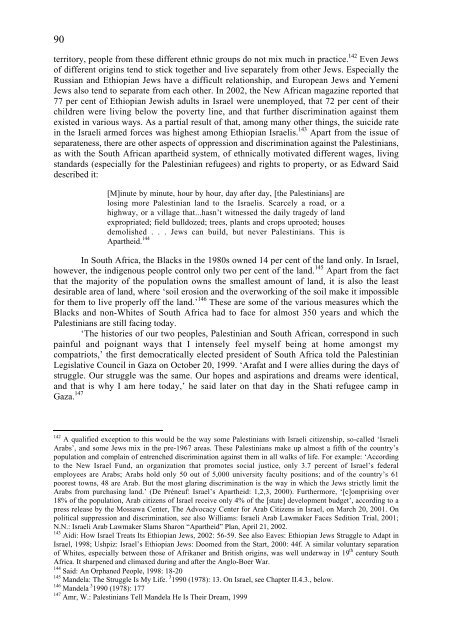Apartheid
Apartheid
Apartheid
Create successful ePaper yourself
Turn your PDF publications into a flip-book with our unique Google optimized e-Paper software.
90<br />
territory, people from these different ethnic groups do not mix much in practice. 142 Even Jews<br />
of different origins tend to stick together and live separately from other Jews. Especially the<br />
Russian and Ethiopian Jews have a difficult relationship, and European Jews and Yemeni<br />
Jews also tend to separate from each other. In 2002, the New African magazine reported that<br />
77 per cent of Ethiopian Jewish adults in Israel were unemployed, that 72 per cent of their<br />
children were living below the poverty line, and that further discrimination against them<br />
existed in various ways. As a partial result of that, among many other things, the suicide rate<br />
in the Israeli armed forces was highest among Ethiopian Israelis. 143 Apart from the issue of<br />
separateness, there are other aspects of oppression and discrimination against the Palestinians,<br />
as with the South African apartheid system, of ethnically motivated different wages, living<br />
standards (especially for the Palestinian refugees) and rights to property, or as Edward Said<br />
described it:<br />
[M]inute by minute, hour by hour, day after day, [the Palestinians] are<br />
losing more Palestinian land to the Israelis. Scarcely a road, or a<br />
highway, or a village that...hasn’t witnessed the daily tragedy of land<br />
expropriated; field bulldozed; trees, plants and crops uprooted; houses<br />
demolished . . . Jews can build, but never Palestinians. This is<br />
<strong>Apartheid</strong>. 144<br />
In South Africa, the Blacks in the 1980s owned 14 per cent of the land only. In Israel,<br />
however, the indigenous people control only two per cent of the land. 145 Apart from the fact<br />
that the majority of the population owns the smallest amount of land, it is also the least<br />
desirable area of land, where ‘soil erosion and the overworking of the soil make it impossible<br />
for them to live properly off the land.’ 146 These are some of the various measures which the<br />
Blacks and non-Whites of South Africa had to face for almost 350 years and which the<br />
Palestinians are still facing today.<br />
‘The histories of our two peoples, Palestinian and South African, correspond in such<br />
painful and poignant ways that I intensely feel myself being at home amongst my<br />
compatriots,’ the first democratically elected president of South Africa told the Palestinian<br />
Legislative Council in Gaza on October 20, 1999. ‘Arafat and I were allies during the days of<br />
struggle. Our struggle was the same. Our hopes and aspirations and dreams were identical,<br />
and that is why I am here today,’ he said later on that day in the Shati refugee camp in<br />
Gaza. 147<br />
142<br />
A qualified exception to this would be the way some Palestinians with Israeli citizenship, so-called ‘Israeli<br />
Arabs’, and some Jews mix in the pre-1967 areas. These Palestinians make up almost a fifth of the country’s<br />
population and complain of entrenched discrimination against them in all walks of life. For example: ‘According<br />
to the New Israel Fund, an organization that promotes social justice, only 3.7 percent of Israel’s federal<br />
employees are Arabs; Arabs hold only 50 out of 5,000 university faculty positions; and of the country’s 61<br />
poorest towns, 48 are Arab. But the most glaring discrimination is the way in which the Jews strictly limit the<br />
Arabs from purchasing land.’ (De Préneuf: Israel’s <strong>Apartheid</strong>: 1,2,3, 2000). Furthermore, ‘[c]omprising over<br />
18% of the population, Arab citizens of Israel receive only 4% of the [state] development budget’, according to a<br />
press release by the Mossawa Center, The Advocacy Center for Arab Citizens in Israel, on March 20, 2001. On<br />
political suppression and discrimination, see also Williams: Israeli Arab Lawmaker Faces Sedition Trial, 2001;<br />
N.N.: Israeli Arab Lawmaker Slams Sharon “<strong>Apartheid</strong>” Plan, April 21, 2002.<br />
143<br />
Aidi: How Israel Treats Its Ethiopian Jews, 2002: 56-59. See also Eaves: Ethiopian Jews Struggle to Adapt in<br />
Israel, 1998; Ushpiz: Israel’s Ethiopian Jews: Doomed from the Start, 2000: 44f. A similar voluntary separation<br />
of Whites, especially between those of Afrikaner and British origins, was well underway in 19 th century South<br />
Africa. It sharpened and climaxed during and after the Anglo-Boer War.<br />
144<br />
Said: An Orphaned People, 1998: 18-20<br />
145 3<br />
Mandela: The Struggle Is My Life. 1990 (1978): 13. On Israel, see Chapter II.4.3., below.<br />
146 3<br />
Mandela 1990 (1978): 177<br />
147<br />
Amr, W.: Palestinians Tell Mandela He Is Their Dream, 1999

















